STARTS Prize
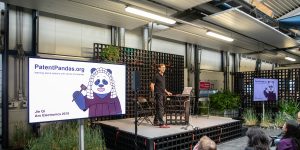
PatentPandas.org
Jie Qi (US), Carol Lin (US), May Qi (US), Ira Winder (US)
PatentPandas.org is a resource built to explain (scary!) patent law using (not-scary!) panda comics. The website has three core parts: Resources: information pages that explain the patent system (like prior art, what is patentable, infringement, etc.) using friendly language and humorous panda comics. Stories: accounts by everyday inventors who had adventures (or misadventures) involving patents and highlights what they learned from their experiences. Get Help: for innovators who are in need of legal support, we compiled a list of pro bono law clinics that offer to help innovators referred from patentpandas.org
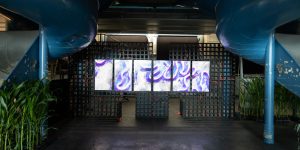
Meandering River
onformative (DE), kling klang klong (DE)
Meandering River is an audiovisual art installation comprised of real-time visuals and music composed by an A.I. through machine learning. The piece reinterprets the shifting behavior of rivers in the landscape, regarded from a bird’s eye view. Minor changes of riverbeds are not visible for the bare eye, as they are gradually happening over time. Spanning over multiple screens Meandering River visualizes these altering landscapes and makes the changes visible. It leaves the observer with a unique perception of time.

Journey on the Tongue
Ayako Suwa (JP), Evala (JP), Yasuaki Kakehi (JP)
Journey on the Tongue is a totally new taste and sound installation which invites you on a spectacular multi-sensory journey. Realized by the three artists Ayako Suwa, the pursuer of "Expressive food," sound artist Evala, the founder of “See by Your Ears,” and media artist Yasuaki Kakehi, who explores new haptic experiences. This work is a new perception of sound and taste.

Ciutat Vella’s Land-use Plan
300.000 Km/s (ES)
Big Data, KDD and Citizen Participation to Ensure Coexistence between Economic Activity and Citizens’ Quality of Life The project embodies a new way of making urban planning. Fueled by massive information (open data and big data) and complemented with qualitative data arising from citizen participation, the project applies novel methodologies of spatial analysis based on machine learning and artificial intelligence to inform, simulate, and draft a public policy that puts the focus on preserving liveability in cities.
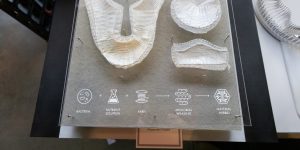
This is grown.
Jen Keane (US)
This is grown. was motivated by a frustration with plastics and a visible disparity between scientific research and design manifestations around natural materials. Taking an organism-driven approach to material design, the project began under the premise that a greater understanding of nature could help us not just replace the petrochemical based materials of today with more sustainable ones, but perhaps allow us to devise entirely new systems of making and categories of materials previously unimagined. After all, nature has had 3.8 billion years to perfect the ultimate circular economy: Life. Maybe we can still learn something.
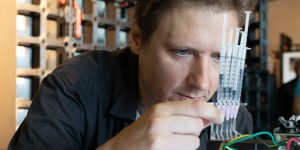
BLP-2000D
BCL – Georg Tremmel (AT), Shiho Fukuhara (JP)
DNA Synthesisers or ‘DNA Printers’ are devices that chemically synthesise or ‘print’ DNA sequences. Currently, the synthesis of long DNA sequences is still an expensive process, therefore DNA Synthesisers are centralised and offered as a service to universities and research institutions. When a specific DNA sequence is ordered, the DNA information is sent to the company, the DNA is synthesised and returned in its physical form, ready to be used for biological experiments. This centralisation also has an intended side-effect: the companies act as censors, controlling which DNA is to be synthesised—and which not. An unofficial ‘Black List’ of potentially harmful and forbidden DNA Sequences has been created and is shared amongst the companies—officially for bio-security reasons. Because of the expensive chemicals involved in the process, it was not really feasible to create a DIY DNA Synthesiser—until now. DIY microfluidics make the process possible and more affordable. But it is still error-prone and creates mutations in the physical DNA sequences. BLP-2000 creates prototype DNA Synthesisers that only print the 'forbidden,' black-listed DNA Sequences. The process of printing black-listed DNA Sequences also creates a moral and societal dilemma.

Beholder
United Visual Artists (UK)
Beholder continues UVA’s investigations into time perception and the relativity of our experiences. It centers around the wonder of everyday phenomena as seen through autistic perspectives, inviting us to re-evaluate our perception of beauty.
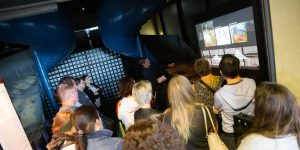
The Murder of Pavlos Fyssas
Forensic Architecture (UK)
Shortly after midnight on 18 September 2013, Pavlos Fyssas, a young Greek anti-fascist rapper, was murdered in his home neighbourhood of Keratsini, Athens. Both the killer and others who participated in the attack were members of the neo-Nazi organization Golden Dawn. Forensic Architecture was commissioned by the Fyssas family and their legal representatives to reconstruct the events of the night from the audio and video material made available to the court. The resulting video investigation and accompanying report, presented to the Athens courtroom on 10 and 11 September 2018, brings together CCTV footage, recordings of communications between police and emergency services, and witness testimony. We established a precise timeline and reconstruction of the events that led to the murder. The investigation established that members of Golden Dawn, including senior officials, acted in a co-ordinated manner in relation to the murder, and that members of Greece’s elite special forces police, known as DIAS, were present at the scene before, during and after the murder, and failed to intervene.

Stone Web – Expanding Space
Idalene Rapp (DE), Natascha Unger (DE)
In Stone Web, Basalt is transformed into a light, stable modular system that can be used for small scale applications such as furnishing or combined to create large, spatial structures or urban furniture. Due to its scalability and production optimization, for example using robotics, future applicability ranges from landscape design to architecture. *Stone Web*, seen equally as an art object and product, finds its place between space, urban object, furniture, architecture, boundary, and installation.
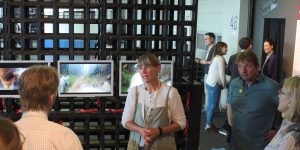
SLAP – See Like A Pony
Sabine Engelhardt (DE)
With SLAP I want to make robotics not only understandable but truly approachable. Clifford Nass drew the comparison of robots with domesticated animals. They are useful, but also dangerous. But, how do we communicate with animals? Can we feel them? How does it work?


